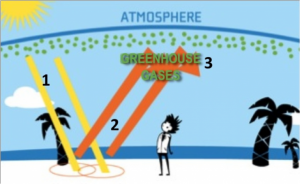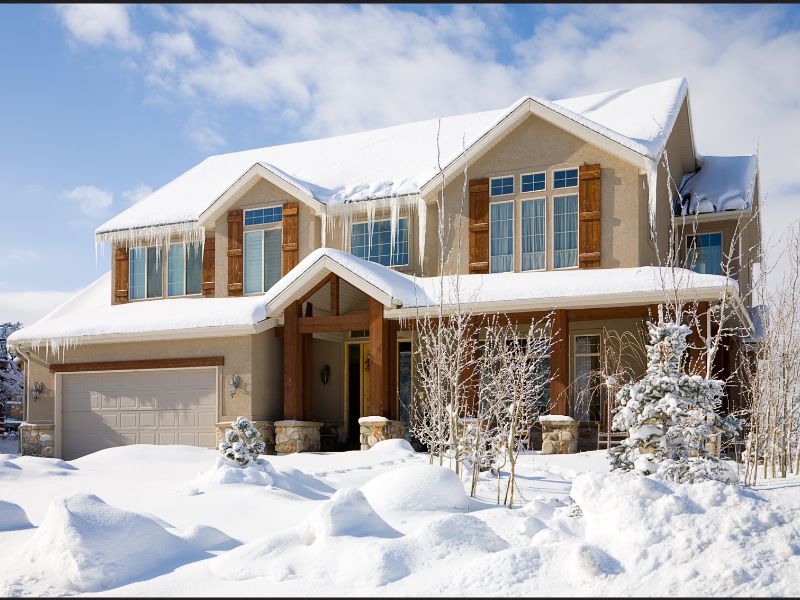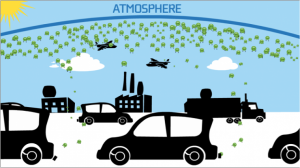The Basic Recipe for Climate Change
Rebecca Anderson
|August 24, 2011

Step 1: Select a good, healthy planet where life is already thriving. (Earth is the only one we know of so far, so we’ll start here.) Mix up a healthy atmosphere of 3 parts nitrogen, 1 part oxygen and just a touch of greenhouse gases. (These are CO2, water vapor, methane and few others and can be found in the air of any well-stocked kitchen.)
Step 2: Blend gases well and observe the natural greenhouse effect with wonderment and awe.

The greenhouse effect in action: (1) Sunlight warms up Earth’s surface. (2) Earth puts out heat. (3) Greenhouse gases trap the heat inside our atmosphere.
Note: The greenhouse effect is highly delicious. Life on Earth would not be possible without it. It keeps Earth’s temperature at a tasteful ~59ºF instead of a frigid 0ºF– unsuitable for proper culinary activities!
Step 3: Now shop around for a good source of energy to meet people’s growing demands: transportation, electricity, heat, cooling, AC, producing all that STUFF we use.
Voila! Add fossil fuels – oil, coal and natural gas. While these ingredients were formerly cheap and abundant, prices are soaring and supply is running low. Look for ingredients in war-torn unstable undemocratic societies.
Step 4: Burn fossil fuels to taste. Now we can drive our cars and trucks, produce electricity and make all our stuff.
Note: Don’t worry if smog starts to fill your kitchen during this step. This is a normal side effect of burning fossil fuels.


Step 5: Repeat burning fossil fuels for next 250 years, burning more every year than you did the year before, or until atmosphere is golden brown.
Step 6: Taste the gases coming out of your tailpipe or smokestack. It’s CO2! (along with some other dirty stuff like sulfur dioxide, hydrocarbons and nitrogen oxides that’s not so good for your lungs, either)
Step 7: Measure the level of CO2 in the atmosphere now. It should have increased from 280 ppm (that’s parts per million) to about 390 ppm—an earth-shaking rise of nearly 40%. That’s like putting an extra scoop of baking soda into the mix. It’s small, but it packs a big punch!
Step 8: Allow planet to bake—without doing anything. You should observe warmer temperatures (about 1.5ºF so far), higher sea levels, melting glaciers, more intense storms and droughts causing flooding, famine and climate refugees, species threatened with extinction, and more acidic oceans.
You’ve now baked up a hot batch of climate change, fresh from the oven. Sprinkle with cinnamon and serve.
Not the freshest eats in the world, huh? Fortunately, there’s another recipe for fixing it – and it involves you. Educate people at your school by bringing ACE to your school for an assembly and starting an Action Team.
Join our Youth Action Network
More Blog Posts

Unnatural, Not Unprecedented
For two weeks, residents of Southern California endured a waking nightmare. Parents raced against time – hurrying down the driveway …
Read MoreCrafting a Vision for the Future: My Experience at LCOY USA 2024
Dry and sunny Tempe, Arizona where temperatures have been over 100 F for 113 consecutive days, delegates gathered to attend …
Read More
7 Ways to Weatherproof Your Home on the Cheap (+1 Not-So-Cheap)
As colder weather sets in, understanding how to weatherproof your home is key to maintaining warmth and reducing energy costs. …
Read More

